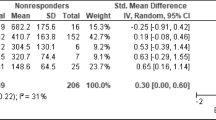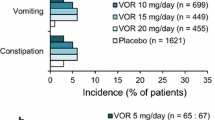Abstract
The objective of this pilot study was to examine the relation between fluvoxamine (FVX) plasma concentrations, therapeutic response and side effects during a four-week treatment period. Twenty‐two patients who met the DSM‐IV criteria for major depression received 100 mg FVX during the first 2 days of treatment and then 150 or 200 mg/day. No clear relationship between plasma concentrations and side effects was detectable. A relationship between plasma concentrations and clinical efficacy was detectable after 21 days but not after 28 days of treatment. These preliminary results indicate that therapeutic drug monitoring might be useful for patients treated with FVX.
Similar content being viewed by others
References
Vozeh S. Cost-effectiveness of therapeutic drug monitoring. Clin Pharmacokinet 1987; 13: 131–40.
Schweitzer C, Spahn H, Mutschler E. Fluorimetric determination of fluvoxamine or clovoxamine in human plasma after thin-layer chromatographic or high-performance liquid chromatographic separation. J Chromatogr 1986; 382: 405–11.
Sandmann J, Lörch B, Bandelow B, Härtter S, Winter P, Hiemke C et al. Fluvoxamine or placebo in the treatment of panic disorder and relationship to blood concentrations of fluvoxamine. Pharmacopsychiatry 1998; 31(4): 117–21.
Spigest O, Granberg K, Hägg S, Söderström E, Dahlqvist R. Non-linear fluvoxamine disposition. Br J Clin Pharmacol 1998; 45(3): 257–63.
Brasseur R, Van Moffaert M, Mesotten F, Ansseau M, Uytdenhoef P, Bartholome F. A Belgian multicentre study of fluvoxamine in depressive outpatients. Acta Psychiatr Belg 1985; 85(5): 636–43.
Lapierre YD, Browne M, Horn E, Oyewumi LK, Sarantidis D, Roberts N et al. Treatment of major affective disorder with fluvoxamine. J Clin Psychiatry 1987; 48(2): 65–8.
Kasper S, Dötsch M, Kick H, Vieira A, Möller HJ. Plasma concentrations of fluvoxamine and maprotiline in major depression: implications on therapeutic efficacy and side effects. Eur Neuropsychopharmacol 1993; 3: 13–21.
De Wilde JEM, Doogan DP. Fluvoxamine and clomipramine in endogenous depression. J Affect Disord 1982; 4: 249–59 (Abstract).
Devane CL, Gill HS. Clinical pharmacokinetics of fluvoxamine: applications to dosage regimen design. J Clin Psychiatry1997; 58(5 Suppl): 7–14.
Kasper S, Dötsch M, Vieira A. Plasma levels of fluvoxamine and maprotiline and clinical response in major depression. Pharmacopsychiatry 1992; 25: 106.
Author information
Authors and Affiliations
Rights and permissions
About this article
Cite this article
Schwarzenbach, F., Demoly, P., Bisschop, D. et al. Antidepressant response and fluvoxamine plasma concentrations: a pilot study. Pharm World Sci 25, 27–29 (2003). https://doi.org/10.1023/A:1022410306577
Issue Date:
DOI: https://doi.org/10.1023/A:1022410306577




